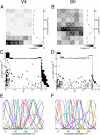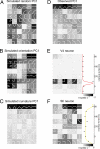Analogous intermediate shape coding in vision and touch
- PMID: 19805320
- PMCID: PMC2738619
- DOI: 10.1073/pnas.0904186106
Analogous intermediate shape coding in vision and touch
Abstract
We recognize, understand, and interact with objects through both vision and touch. Conceivably, these two sensory systems encode object shape in similar ways, which could facilitate cross-modal communication. To test this idea, we studied single neurons in macaque monkey intermediate visual (area V4) and somatosensory (area SII) cortex, using matched shape stimuli. We found similar patterns of shape sensitivity characterized by tuning for curvature direction. These parallel tuning patterns imply analogous shape coding mechanisms in intermediate visual and somatosensory cortex.
Conflict of interest statement
The authors declare no conflict of interest.
Figures



References
-
- Zangaladze A, Epstein CM, Grafton ST, Sathian K. Involvement of visual cortex in tactile discrimination of orientation. Nature. 1999;401:587–590. - PubMed
-
- Amedi A, Malach R, Hendler T, Peled S, Zohary E. Visuo-haptic object-related activation in the ventral visual pathway. Nat Neurosci. 2001;4:324–330. - PubMed
-
- Merabet L, et al. Feeling by sight or seeing by touch? Neuron. 2004;42:173–179. - PubMed
Publication types
MeSH terms
LinkOut - more resources
Full Text Sources

